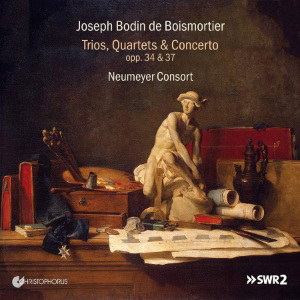
Joseph Bodin de Boismortier (1689-1755)
Trios, Quartets & Concerto
Neumeyer Consort
rec. 2019 at the SWR Studio Kaiserslautern, Germany DDD
Reviewed as a stereo 16/44 download from Naxos
Christophorus CHR77450 [73]
Joseph Bodin de Boismortier was one of the most remarkable composers of his time. Unlike others, he was never in the service of a town, court or church. This allowed him to compose exactly as he wanted, and he decided to provide the growing number of amateurs of his time with good music to play. This explains why he either left the choice of instruments to the performers, which means that they could use what was at their disposal, or offered several alternatives on the title pages of the printed editions. Don’t be surprised if you find some of the pieces on the present disc in other recordings in performances with different instruments or combinations of instruments. That said, the transverse flute plays a key role in Boismortier’s output, as this was in his time the most popular instrument among amateurs.
A typical Boismortier collection is the Op. 34. It came from the press in 1731 and is scored for four parts: three melody instruments and basso continuo. The title page says that these sonatas can be played on three transverse flutes or violins, “or other instruments”. Interestingly, it is added that the first melody part can be played on the recorder, “if that is necessary”. This indicates that the recorder was well on its way out and was largely overshadowed by the transverse flute, but that it was still played by amateurs. This justifies the line-up on the present disc, in which the recorder is is involved in four of the six quartets. The fashionable transverse flute participates in the other two.
The Op. 37 is another interesting collection. It was printed in 1732 and includes five trio sonatas for a treble instrument and a bass; this again allows for a variety of scorings which the performers have explored to full extent. The treble parts are played by transverse flute, oboe or violin, whereas in the bass parts we hear cello, viola da gamba or bassoon. The set ends with a concerto in five parts: the four melody parts are specifically scored for flute, oboe, violin and bassoon. This scoring indicates that there is a strong similarity between this piece and the concerti da camera in the oeuvre of Antonio Vivaldi.
That leads us to the question how this music should be performed. There is no doubt about the influence of Vivaldi, whose music was gaining popularity very quickly in France, and generally the Italian style. On the other hand, these pieces are written in the galant idiom, and the French still preferred modesty in the way music was performed. Some interpreters, such as the flautist Jed Wentz, prefer a rather dramatic approach to this repertoire, and emphasize contrasts in tempo and dynamics. Most performers opt for a more restrained interpretation, and the Neumeyer Consort seems one of them. I can appreciate both ways of performing Boismortier’s music.
The Neumeyer Consort certainly plays these pieces well, and there is no lack of entertainment. And exactly that is what this music intends to offer – nothing more. Even so, I feel that sometimes a more extroverted approach would not have been amiss, but that may well be a matter of taste.
Boismortier’s music indeed intends to entertain, first of all the players, but then also those who are listening. He knew what he was doing, and it does not surprise that his music did sell well and allowed him to make a living from his compositions. This disc is a good addition to any collection of discs with 18th-century music, and will give the listener something to enjoy, also thanks to the performances and the variety in the line-up.
Johan van Veen
www.musica-dei-donum.org
twitter.com/johanvanveen
Help us financially by purchasing from



Contents
Concerto in E minor, op. 37,6
Quartet in A minor, op. 34,6
Trio in D, op. 37,3
Quartet in E minor, op. 34,3
Trio in A minor, op. 37,5
Quartet in D, op. 34,4
Trio in G minor, op. 37,4
Quartet in D minor, op. 34,5
Trio in E minor, op. 37,2
Quartet in G, op. 34,2
Trio in G, op. 37,1
Quartet in G minor, op. 34,1


















